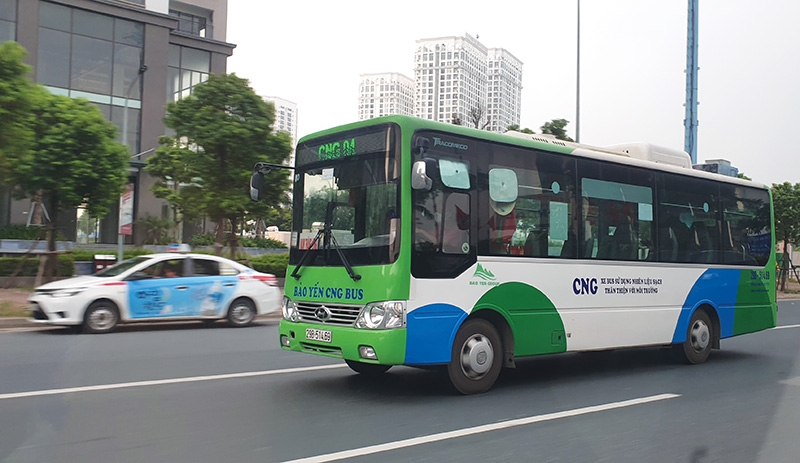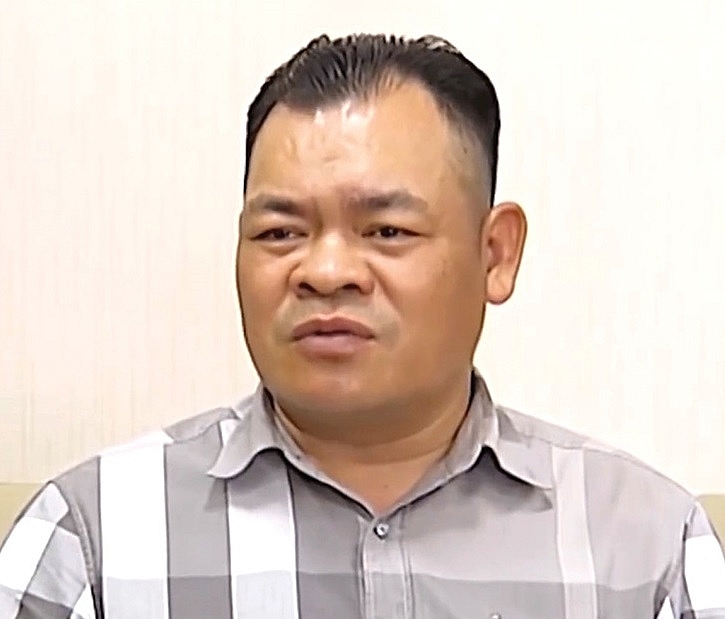Greener city transport ahead
 |
| Larger Vietnamese cities are racing to find solutions for eco-friendly and sustainable public transport |
Hanoi and Ho Chi Minh City have become familiar names among the most polluted cities with the worst air quality worldwide. According to statistics from AirVisual, Hanoi’s air quality index (AQI) consistently exceeds national standards, staying in the 101-200 range. In particular, the PM2.5 level on September 17 reached 111.3 μg/m3, 4.5 times higher than the national standard and 11.1 times higher than the World Health Organization’s annual average.
One of the biggest sources of air pollution is vehicle emissions, especially since the number of private vehicles like cars and motorcycles has increased significantly over the years. As a result, Vietnam’s biggest cities such are researching and implementing several projects to develop public transport services, in which priority is given to models using eco-friendly energy sources.
Hanoi recently considered putting electric buses into service after Vingroup’s passenger transportation establishment VinBus proposed to operate 10 new green-energy bus routes. Vingroup also pledged to invest in 150-200 high-end electric buses, a smart bus management and operation centre, a technical station, battery charging station networks, and overnight parking stations for the electric bus system.
Such statements immediately attracted great attention from the public. Many people expect that, along with other public transport models such as the bus rapid transit (BRT) and sky trains, electric buses will contribute to improving public transport services, while reducing air pollution that frequently reaches alarming levels in Hanoi.
More eco-friendly models
Electric buses are not the first types of public transport using clean fuels in Hanoi and elsewhere in Vietnam.
In 2018, 50 buses running on compressed natural gas (CNG) operated by Bao Yen Tourism and Construction Services Co., Ltd. were put into operation in Hanoi. By the end of 2019, the city had a total of seven bus routes using CNG buses. Meanwhile, Ho Chi Minh City has been testing the model for nearly a decade and is implementing a project to gradually replace conventional buses with CNG ones.
The gas used in CNG buses contains mostly methane, ethane, propane, butane, and pentane, which are deemed friendly with the environment, according to experts. CNG buses have different safety and economic concerns than diesel buses, and the fuel cost is only 55 per cent of the gasoline price, 42 per cent of the diesel price.
Moreover, there are other advantages leaning towards being greener, such as a long engine life that helps to reduce the cost of maintenance and the risk of fire.
Despite possessing many plus points, the wider introduction of CNG buses in the sector faces obstacles such as the cost of new investment or installation of expensive CNG converters, along with the lack of appropriate filling stations.
Vietnam currently has only three CNG filling stations for these busses; one in Phu My, Dong Nai, one station near Ho Chi Minh City’s Tan Son Nhat International Airport, and one placed at the headquarters of Bao Yen Transport JSC in Dong Anh, Hanoi.
In addition to the CNG bus model, solar-powered buses were also piloted on Cat Ba Island as a result of a partnership between Haiphong and Japan’s Kitakyushu City in 2017.
In 2017, Ho Chi Minh City Department of Transport also organised the opening of the first four unsubsidised electricity-powered bus routes. These buses run around many streets and landmarks located in District 1 and in Phu My Hung’s new urban area. A ticket for these non-subsidised routes costs VND6,000 (20 US cents) for half the route and VND12,000 (40 US cents) for the whole route.
Assoc. Prof. Dr. Nguyen Xuan Mai from Ho Chi Minh University of Technology said, “The application of electric buses is very feasible. If compared to subways or BRTs, the consolidated investment cost per kilometre of an electric bus is only about a quarter of that of the BRT and equal to 3-4 per cent of the investment cost of a subway system.”
Electric buses are expected to attract a large number of passengers, able to quickly relieve traffic congestions at peak hours and furthering a promising development of the public transport sector.
An inevitable trend
According to Vu Tan Cong, deputy general director at Vietnam Automobile Industry and Trade Consulting Co., Ltd, electric buses are not the only solution for public transport as there are also subways and sky trains. However, along with the CNG bus model, electric buses will be a very useful solution in solving environmental and urban transport problems.
“Hanoi and Ho Chi Minh City have been trying out CNG buses, but have little experience with electric ones. But better late than never. Hanoi has many advantages to widely deploy electric bus routes. Meanwhile, it is difficult for Ho Chi Minh City to operate this model due to frequent flooding as the batteries of electric buses are usually located under the floor. If flooded, they would completely fail,” said Cong.
Representatives of the Department of Transport of Ho Chi Minh City admitted that despite being supported by the city, the current transport infrastructure still faces many obstacles, such as designing separate lanes for electric buses and promoting their usage with passengers.
Clays Nguyen, a commuter from Ho Chi Minh City’s Binh Thanh district commented, “When Ho Chi Minh City opened four tram routes, I have tried them out, but they are not as convenient as regular buses due the large intervals of up to 30 minutes between each trip. Moreover, trams only pass through tourist destinations and do not include many public offices and corporate headquarters, so it is difficult for people to use trams to get to work. However, I strongly support this model as it will contribute to reducing pollution in the city whenever it becomes more convenient.”
Globally, the widespread application of electric buses is also lagging behind, though many countries have developed these systems for a long time. However, up until now only about 17 per cent of the world’s buses are electric.
According to the 2020 Electric Vehicle Outlook by Bloomberg New Energy Finance, there are more than 400,000 electric buses in the world and 98 per cent of them are already deployed in more than 30 cities in China.
A representative of Hanoi Transport Service Corporation (Transerco) commented that the transition from conventional gasoline and diesel buses to eco-friendly fuels such as CNG and electricity will become an inevitable trend in the future, but it requires a long preparation.
In the short term, Transerco has no plans for such a transformation.
Although there are still many concerns about the wide application of the model, eco-friendly buses are still considered the public transport means of the future, contributing to solving traffic and environmental problems for cities.
| Nguyen Anh Tuan - Director, Bao Yen Tourism and Construction Services Co., Ltd.
Bao Yen Tourism and Construction Services, Co., Ltd. specialises in doing business on passenger transport by buses in Hanoi so its routes are also subsidised by the city and we will continue to open more buses running on CNG. Over the past two years, the company has carried out research in the field of electric buses, we have also organised overseas missions to survey this model, but the cost to develop the electric bus model is very high compared to our current budget. Therefore, the company will continue to research and propose to Hanoi to operate not only big CNG buses but also small ones that can run in narrow streets or alleys. Nguyen Hoang Yen - Housewife, Hanoi
Two years ago, I got on a CNG bus for the first time and was amazed at the open and friendly attitude of the driver and the staff. Compared to regular buses, I find the bus running on clean fuels runs smoothly and there’s no smell or particulate matter. The space is also open and clean, so it is less likely to cause travel sickness. Buses running on clean fuels have better quality than conventional buses, especially suitable for the elderly and children. I hope there will be more eco-friendly bus routes to replace the old models and help people who are travelling within the city or suburbs to experience the comfort and modernity of this kind of public transport. Luong Xuan Thu - Student, Hanoi
I like that there is also free wifi on buses running on clean fuels, which is really a plus point that helps passengers who travel by bus like me to take advantage of the time to learn or relax while travelling. The fare for a bus that runs on clean fuel is similar to that of a conventional bus, monthly interline tickets are available, allowing students like me to save on travel costs while having a more pleasant experience. With frequent traffic congestion in big cities today, the transition to CNG buses and electric buses in the upcoming time will contribute to reducing environmental pollution and make those who have to travel during peak hours less uncomfortable because of the emissions. |
What the stars mean:
★ Poor ★ ★ Promising ★★★ Good ★★★★ Very good ★★★★★ Exceptional
Related Contents
Latest News
More News
- Ho Chi Minh City hits $8.37 billion in FDI (December 29, 2025 | 08:28)
- Tax sector wraps up 2025 and sets priorities for next year (December 25, 2025 | 14:00)
- Heavy industries set for pilot greenhouse gas quotas (December 25, 2025 | 10:00)
- $250 million deal targets women-owned SMEs, sustainable agriculture (December 22, 2025 | 17:40)
- UOB sees Vietnam growth easing in fourth quarter (December 22, 2025 | 17:39)
- Government moves to establish International Financial Centre (December 21, 2025 | 21:00)
- Vietnam's IFC to target global investment flows (December 21, 2025 | 18:00)
- Ha Tinh breaks ground on major Vingroup industrial and energy projects (December 19, 2025 | 18:24)
- EVN launches major power infrastructure projects nationwide (December 19, 2025 | 18:17)
- VAL inaugurates second production line to meet domestic animal feed demand (December 19, 2025 | 16:37)




 Tag:
Tag:





















 Mobile Version
Mobile Version